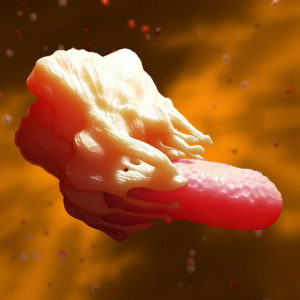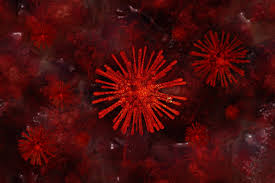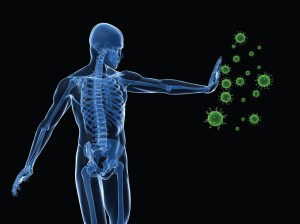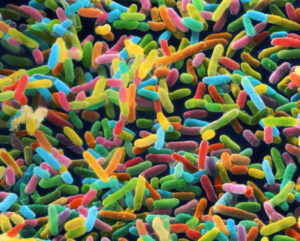Highlights
- •mSWI/SNF complex and its ATPase subunit are epigenetic dependencies in SCLC-P
- •POU2F3 complex requires the mSWI/SNF complex to modulate chromatin accessibility
- •POU2AF1 and IRF4 function as an epigenetic complex requiring mSWI/SNF in MM
- •An oral mSWI/SNF ATPase degrader shows potent anti-tumor efficacy in SCLC-P and MM
Summary
The POU2F3-POU2AF2/3 transcription factor complex is the master regulator of the tuft cell lineage and tuft cell-like small cell lung cancer (SCLC). Here, we identify a specific dependence of the POU2F3 molecular subtype of SCLC (SCLC-P) on the activity of the mammalian switch/sucrose non-fermentable (mSWI/SNF) chromatin remodeling complex. Treatment of SCLC-P cells with a proteolysis targeting chimera (PROTAC) degrader of mSWI/SNF ATPases evicts POU2F3 and its coactivators from chromatin and attenuates downstream signaling. B cell malignancies which are dependent on the POU2F1/2 cofactor, POU2AF1, are also sensitive to mSWI/SNF ATPase degraders, with treatment leading to chromatin eviction of POU2AF1 and IRF4 and decreased IRF4 signaling in multiple myeloma cells. An orally bioavailable mSWI/SNF ATPase degrader significantly inhibits tumor growth in preclinical models of SCLC-P and multiple myeloma without signs of toxicity. This study suggests that POU2F-POU2AF-driven malignancies have an intrinsic dependence on the mSWI/SNF complex, representing a therapeutic vulnerability.
Introduction
Small cell lung cancer (SCLC) is an aggressive, fast-evolving subtype of lung cancer with a high growth rate and early metastasis propensity, often resulting in a more advanced disease stage at diagnosis.1,2 Consequently, the overall prognosis for SCLC is generally poorer compared to non-small cell lung cancer (NSCLC).3 Unlike NSCLC, where substantial progress has been achieved with immune checkpoint blockade therapies, effective targeted therapies for SCLC remain elusive.4 Comprehensive genome sequencing of SCLC tumors has revealed a high mutational load in this disease, with most tumors possessing inactivating mutations or deletions of RB1 and TP53, but few actionable targets have been identified.5 Thus, there is an urgent need for innovative therapeutic strategies that address the distinct biology of SCLC and enhance patient outcomes.
Prior analysis of human SCLC tumors reveals that SCLC can be characterized by the expression pattern of certain transcription factors (TFs) or transcriptional regulators, including ASCL1 (achaete-scute family bHLH transcription factor 1), NeuroD1 (neurogenic differentiation factor 1), POU2F3 (POU domain class 2 transcription factor 3; also known as OCT-11), and YAP1 (yes-associated protein 1), exemplifying SCLC as a TF-driven malignancy.6,7,8,9 ASCL1-driven SCLC (SCLC-A) and NeuroD1-driven SCLC (SCLC-N) manifest a neuroendocrine phenotype, while POU2F3-driven SCLC (SCLC-P) is characterized as a tuft cell-like variant.9 Prior studies reveal that POU domain class 2 TFs uniquely rely on coactivators to achieve their lineage-defining functions in B cells.10,11,12,13 More recently, in tuft cell-like SCLC cells, the coactivators of POU2F3 (POU2AF2 and POU2AF3) were found to endow POU2F3 with a critical transactivation domain by forming a master regulator complex, which supports enhancer-mediated cancer-promoting gene activation in SCLC-P cells.14,15,16 This indicates a potential therapeutic vulnerability in patients with tuft cell-like SCLC whereby strategies aimed at blocking POU2F3-POU2AF2/3 function may lead to clinical benefit.
The mammalian switch/sucrose non-fermentable (mSWI/SNF) chromatin remodeling complex acts as a pivotal regulator of gene expression and chromatin architecture, thereby orchestrating fundamental cellular processes crucial for homeostasis and development.17 The ATPase subunit of this complex harnesses energy from ATP hydrolysis to reposition or eject nucleosomes at non-coding regulatory elements, facilitating unobstructed DNA access for the transcriptional machinery.18,19,20 Recent investigations have elucidated alterations in the genes encoding constituent subunits of the mSWI/SNF complex in over 25% of human malignancies.21,22 Our group recently discovered that androgen receptor (AR)-driven prostate cancer cells are preferentially dependent on the chromatin remodeling function of the mSWI/SNF complex.23 We identified a mSWI/SNF ATPase proteolysis targeting chimera (PROTAC) degrader that dislodges AR and its cofactors from chromatin, disabling their core enhancer circuitry, and attenuating downstream oncogenic gene programs.23 Similar observations have been reported in other TF-driven malignancies like acute myeloid leukemia,24,25 highlighting the broad applicability of targeting the mSWI/SNF complex in a variety of malignancies.
In this study, we identified an enhanced dependency on the mSWI/SNF complex in POU2F3-driven SCLC cells through CRISPR screening and pharmacological validation. Epigenomics analyses revealed that inactivation of the mSWI/SNF complex preferentially obstructed chromatin accessibility of POU2F3 complexes, leading to a dramatic downregulation of POU2F3 signaling. Critically, treatment with an orally bioavailable mSWI/SNF ATPase PROTAC degrader resulted in significant tumor growth inhibition in preclinical models of POU2F3-driven SCLC without significant effects in other subtypes of SCLC xenografts. Furthermore, our investigations extended to other POU2AF1 complex-dependent B cell malignancies, mainly multiple myeloma, wherein sensitivity to the mSWI/SNF ATPase PROTAC degrader was observed in vitro and in vivo. These findings collectively show the potential of targeting the mSWI/SNF complex in POU2F-POU2AF-driven malignancies and suggest that development of mSWI/SNF degraders should be pursued as targeted therapies for patients with these types of cancers.
Results
Dependence of SCLC-P cells on the mSWI/SNF complex
SCLCs are genetically driven by loss of function (LOF) alterations in tumor suppressor genes RB1 and TP53,5 with distinct expression patterns of certain TFs or transcriptional regulators leading to four molecular subtypes (SCLC-A, SCLC-N, SCLC-P, and SCLC-Y (YAP1)).6 Functional genomics analyses have underscored the critical roles of these TFs or coactivators in each SCLC molecular subtype. However, unlike kinases, many TFs have been perceived as undruggable targets due to their enrichment of intrinsically disordered regions within their structures, indicating potential challenges in devising ASCL1 or POU2F3-direct targeting strategies. Considering this, we hypothesized that druggable targets selective to SCLC subtypes could be identified via a loss-of-function CRISPR-Cas9 screen. Accordingly, we conducted a functional domain-targeted CRISPR-Cas9 screen co-targeting paralog pairs of kinases, phosphatases, epigenetic regulators, and DNA binding proteins in three SCLC-A and three SCLC-P cell lines (Figure 1A). Dependency scores (beta scores) for 4,341 single-gene and 4,387 double-gene knockouts were calculated using MAGeCK.26 Comparing beta scores between SCLC-A and SCLC-P cell lines, we observed dramatic dependency differences for lineage TFs ASCL-1 and POU2F3. Surprisingly, we also identified a strong dependency bias of multiple components of the mSWI/SNF complex in SCLC-P cells (Figures 1B–1D, S1A, and S1B, Table S1).
We hypothesized that this selective dependency might originate from a POU2F3-imposed requirement on the mSWI/SNF complex. Among the mSWI/SNF complex components, only ATPases and bromodomain containing 9 (BRD9) were found to be directly targetable by recently developed PROTAC degraders, which have been engineered to induce target protein degradation through the ubiquitin-proteasome system (Figure S1B, Table S1).27,28 Our team recently showcased the promising anti-tumor efficacy of the PROTAC degrader targeting the mSWI/SNF ATPase subunit in preclinical models of AR-driven prostate cancer.23 Here, we evaluated the efficacy of this mSWI/SNF ATPase PROTAC degrader, AU-15330, across a spectrum of SCLC cell lines. AU-15330 treatment resulted in time and dose-dependent degradation of mSWI/SNF ATPases (SMARCA2 and SMARCA4) and PBRM1 in cell lines encompassing different molecular subtypes of SCLC (Figures 1E and S1C). Protein levels of POU2F3 and its coactivator POU2AF2 were also decreased in SCLC-P cells treated with AU-15330 at extended time points (12 and 24 h, Figures 1E and S1C). Despite degradation of target mSWI/SNF ATPase proteins across subtypes, AU-15330 exhibited a preferential growth inhibitory effect and induced apoptosis in SCLC-P cells compared to all non-POU2F3 SCLC cell line models (Figures 1F and S1D–S1F). Furthermore, analysis of publicly available SCLC patient data showed that SCLC-A patients had a higher frequency of mutations in mSWI/SNF components compared to SCLC-P patients (Figure S1G). Taken together, our functional CRISPR-Cas9 screen, complemented by secondary pharmacological validation, pinpointed the mSWI/SNF complex and its catalytic ATPase subunit as epigenetic dependencies in SCLC-P cells.
Mechanism of action of mSWI/SNF complex inactivation in SCLC-P cells
Experiments were next performed to elucidate the mechanism of action underlying the selective growth inhibitory effects of the mSWI/SNF ATPase PROTAC degrader in SCLC-P cells. Given the primary role of the mSWI/SNF complex in modulating chromatin accessibility by altering nucleosome positioning along DNA, we employed assay for transposase-accessible chromatin using sequencing (ATAC-seq) in SCLC-P and SCLC-A cells post AU-15330 treatment. As depicted in Figures 2A and S1H, 4 h treatment with AU-15330 triggered rapid and genome-wide chromatin accessibility loss at regulatory regions in both SCLC-P and SCLC-A cells. De novo motif analysis of the sites affected by AU-15330 revealed that POU motif-containing sites were predominantly affected across the genome in SCLC-P cells (Figures 2B, S1I, and S2A–S2D). Conversely, the ASCL1 motif-containing sites were only mildly impacted upon AU-15330 treatment in ASCL1-expressing NCI-H69 cells (Figures 2B, S2E, and S2F), suggesting that chromatin accessibility of ASCL1-targeting regions is largely independent of the mSWI/SNF complex. Concurrent with the loss of chromatin accessibility, chromatin immunoprecipitation followed by sequencing (ChIP-seq) showed diminished chromatin binding of POU2F3 and its coactivators (POU2AF2 and POU2AF3) at the AU-15330-mediated loss sites, as examined by tagging endogenous or exogenous POU2F3 and its coactivators in SCLC-P cell lines (Figures 2C and S2G–S2M). Notably, loss of chromatin accesibility and occupancy of POU2F3 and POU2AF2 were detected at 4 h AU-15330 treatment, prior to changes observed in their protein levels (Figures 1E and S1C); this suggests that SMARCA2/4 degradation directly affects physical access of POU2F3 and its coactivators to DNA.
Given the pronounced impact on POU motif-containing sites upon mSWI/SNF complex inactivation, we hypothesized an association between the mSWI/SNF complex and the POU2F3 complex in SCLC-P cells. To explore this, we conducted fast protein liquid chromatography (FPLC) experiments to size fractionate nuclear lysates from two SCLC-P cell lines. We observed several mSWI/SNF complex components (SMARCD1, ARID1A, and SS18), POU2F3, and POU2AF2 co-expressed in the large nuclear fractions (Figure S3A), suggesting a potential coexistence of the POU2F3 complex and the mSWI/SNF complex within a large nuclear protein complex. Further, rapid immunoprecipitation mass spectrometry of endogenous proteins (RIME) analysis of POU2F3 and its coactivators’ interactome revealed multiple key mSWI/SNF components coimmunoprecipitated with POU2F3 and its coactivators (Figures 2D and S3B–S3E, Table S1), affirming the physical association between the POU2F3 complex and the mSWI/SNF complex in SCLC-P cells. Real-time quantitative reverse transcription PCR (RT-qPCR) and global transcriptomic profiling via RNA sequencing (RNA-seq) showcased significant downregulation of POU2F3, POU2AF2/3, and their downstream targets (e.g., PTGS1) in multiple SCLC-P cell lines (Figures 2E and 2F). The gene set enrichment analysis (GSEA) of global AU-15330-mediated transcriptomic alterations reflected a high concordance between mSWI/SNF inactivating gene signatures and transcriptional signatures associated with genetic knockout of POU2F3 and its coactivators (Figures 2G and S3F).15 Additionally, we observed a consistent reduction in ATAC-seq and ChIP-seq signals at several well-established POU2F3 target genes (Figures 2H and S2M). Collectively, our multi-omics analysis suggests that the POU2F3 complex necessitates the mSWI/SNF complex to modulate chromatin accessibility at its DNA binding regions, thereby transactivating the POU2F3 downstream signaling pathway in SCLC-P cells.
Selective inhibition of SCLC-P xenograft tumor growth by AU-24118
To enhance the translational relevance of our findings, we developed an orally bioavailable SMARCA2/4 PROTAC degrader, named AU-24118, which exhibits enhanced pharmacokinetic (PK) properties compared to AU-15330.29 AU-24118 effectively degraded SMARCA2, SMARCA4, and PBRM1, and displayed a preferential growth inhibitory effect for SCLC-P cell lines compared to SCLC-A, SCLC-N, and SCLC-Y cell lines (Figures S3G and S3H). These findings were similar to those shown in Figure S1D for AU-15330, with both SMARCA2/4 degraders inhibiting growth of SCLC-P cells at IC50 values in the low nanomolar range.
To define the anti-tumor efficacy of AU-24118 in SCLC, the drug was administered orally at 15 mg/kg, three times weekly, to immunodeficient mice bearing subcutaneous SCLC tumors representing the SCLC-P (NCI-H526 and NCI-H1048) and SCLC-A (NCI-H69) molecular subtypes (Figure 3A). Notably, significant reductions in SCLC-P tumor volumes (Figure 3B) and tumor weights (Figure S3I) were observed post-oral administration of AU-24118. Conversely, AU-24118 treatment did not significantly alter tumor growth of NCI-H69 SCLC-A xenografts (Figures 3B and S3I), thereby confirming the selective anti-tumor efficacy of mSWI/SNF ATPase degraders in SCLC-P preclinical models. Aligning with our observations in vitro, SCLC-P tumors treated with AU-24118 exhibited significant degradation of its direct targets (SMARCA2/4 and PBRM1), which ensued in downregulation of POU2F3, POU2F3 coactivators, and downstream target GFI1B (Figure 3C). Additionally, levels of cleaved PARP were increased in SCLC-P tumors treated with AU-24118, while N-MYC levels decreased (Figure 3C). Histopathological assessments performed on AU-24118-treated SCLC-P tumors showed increased apoptotic bodies and intra-tumoral nuclear and necrotic debris in contrast to highly cellular and monotonous appearing, high-grade vehicle-treated tumor samples (Figures 3D and S3J). Fluorometric terminal deoxynucleotidyl transferase (TUNEL) assay analysis confirmed a significant increase in TUNEL-positive cells in SCLC-P but not SCLC-A tumors (Figure 3E). Immunohistochemistry (IHC) further confirmed a dramatic loss of SMARCA4 and POU2F3 protein expression in the AU-24118-treated SCLC-P tumors, as well as decreased DCLK1 expression—a tuft cell marker (Figures 3D and S3J). Despite no changes in tumor growth in the SCLC-A xenografts, immunoblotting and IHC analysis of tumors confirmed on-target drug activity of AU-24118 as indicated by efficient loss of SMARCA4, SMARCA2, and PBRM1 (Figures 3C and S3K)…







